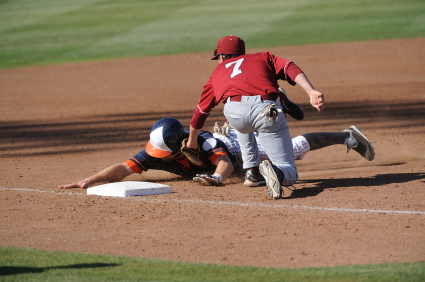The Situation: Man on second, two outs, the five-hitter is at the plate with a 1-2 count. The runner on second has good speed. The game is tied at 2.
The Play: The runner at second knows that the pitcher can afford to waste a pitch with a 1-2 count. As the pitch leaves the pitcher’s hand, the runner on second reads the angle as a ball-in-dirt. He breaks out of his secondary and takes off for third.
The Outcome: The pitch bites down into the dirt, but the catcher picks it cleanly. He immediately hops up and fires a throw to third. The third baseman slaps on the tag for the third out of the inning.
What Went Wrong?
There’s an old baseball saying that you should never make the first or third out at third base. The reason is that, with nobody out, you want to give the hitter a chance to move the runner over, and with two outs, you want to give the hitter a chance to drive them in.
It’s always good to look for opportunities to be aggressive on the base paths – but you have to be smart too. With two outs, a runner on second has to understand that he can’t try and take third base unless he sees the ball bounce away from the catcher. You can’t break early, when you recognize the angle of the pitch out of hand, because of the possibility that the catcher will pick it cleanly, like in this scenario. By getting thrown out at third, the runner sacrificed a situation where a base hit would get his team a run, especially since the runner had good speed.
Here are the general rules for when to be aggressive on a ball-in-dirt. As a runner on first, you will always be aggressive. You always want to get yourself into scoring position.
As a runner on second, you only want to be aggressive with one out. With nobody out, you have to give the hitter a chance to bunt you over, or advance you by hitting something to the right side. With two outs, you need to be content with being in scoring position, and get ready to score on a base hit.
As a runner on third, you are only going to be aggressive with two outs. With 0 or 1 out, you should give the hitter a chance to drive you in. With two outs, you don’t want to bank on a base hit. Try to steal a cheap run however you can.
There are certainly situations where you can take the extra 90 feet when you aren’t being aggressive on the bases. For instance, if you’re on second with two outs, and the ball bounces 10 feet away from the catcher, take third. When I say “aggressive” for these situations, I mean that you’re reading the angle of the ball out of the pitcher’s hand, and trying to break for the next bag before the ball has hit dirt.
Always remember, in college, the best base runners aren’t necessarily the fastest. A lot of times, they’re the guys that can think on the base paths and use situations to their advantage. Always know what situation you’re in when you’re on the bases. Think the game.







